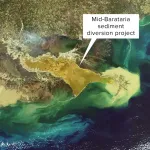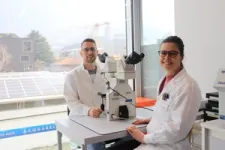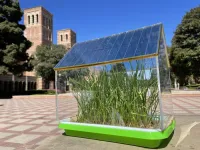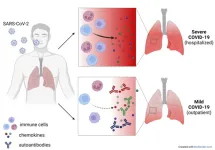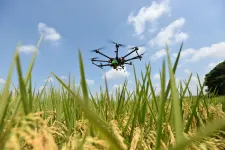(Press-News.org) Research from scientists at Louisiana State University and Indiana University reveals new information about the role humans have played in large-scale land loss in the Mississippi River Delta—crucial information in determining solutions to the crisis.
The study published today in Nature Sustainability compares the impacts of different human actions on land loss and explains historical trends. Until now, scientists have been unsure about which human-related factors are the most consequential, and why the most rapid land loss in the Mississippi River Delta occurred between the 1960s and 1990s and since has slowed down.
“What we found was really surprising,” said Doug Edmonds, lead author on the study and an associate professor of Earth and atmospheric sciences at Indiana University Bloomington. “It is tempting to link the land loss crisis to dam building in the Mississippi River Basin—after all, dams have reduced the sediment in the Mississippi River substantially. But in the end, building levees and extracting subsurface resources have created more land loss.”
The current Mississippi River Delta formed over the past 7,000 years through sediment deposition from the river near the Gulf Coast. But due to human efforts to harness the river and protect communities, sediment accumulation is no longer sufficient to sustain the delta. As a result, coastal Louisiana has lost about 1,900 square miles of land since the 1930s, according to the Louisiana Coastal Protection and Restoration Authority.
The study found that only about 20 percent of the land loss is due to dam building, while levee building and extracting subsurface resources, such as oil and gas, each account for about 40 percent of the Mississippi River Delta land loss. The study also suggests the most rapid land loss and the recent deceleration might be related to the reduction of subsurface resource extraction.
To conduct their study, researchers re-created the land loss for an area in the Mississippi River Delta called the Barataria Basin. They used a model that describes the sediment budget, which is the balance between sediment flowing in and out of a coastal system. Using that model, they quantified the impact that building dams and levees and extracting subsurface resources had on land loss.
LSU leaders on the study were Robert R. Twilley, professor of oceanography and coastal sciences and interim vice president of research and economic development; Samuel J. Bentley, professor and the Billy and Ann Harrison Chair in Sedimentary Geology; and Kehui Xu, director of the LSU Coastal Studies Institute and James P. Morgan Distinguished Professor of Oceanography & Coastal Sciences along with LSU Civil & Environmental Engineering alumnus Christopher G. Siverd, who is a coastal engineer at Moffatt & Nichol.
“This study emphasizes the importance of doing a broad systems analysis of complex problems, so we really can have confidence in the solutions we’re proposing to reverse land loss and protect our land and people,” Twilley said. “There’s a possibility river diversions might have more impact in building wetlands than we anticipated.”
The 2023 Coastal Master Plan for Louisiana prioritizes restoring the processes that naturally build land in the delta. The Mid-Barataria Sediment Diversion, which is the largest coastal land restoration project in Louisiana at more than $2 billion, will release sediment and water from the Mississippi River into the adjacent Barataria Basin.
“Our work suggests the Mid-Barataria Sediment Diversion is the right tool for the job to counter land loss due to subsidence and sea level rise,” Bentley said. “Overall, this study offers perhaps a rosier outlook than some other analyses on our ability to engineer with nature to reverse land loss.”
As resource extraction has decreased in recent years, the relative impact of levees on Louisiana coastal land loss is trending higher. That impact, however, could potentially be offset by sediment diversions.
“Findings strongly suggest the Mid-Barataria sediment diversion and other sediment diversions along the Mississippi River will provide long-term land-building capability and reduce future land loss in southeast Louisiana,” Siverd said.
END
New study compares human contributions to Mississippi river delta land loss, hints at solutions
2023-03-06
ELSE PRESS RELEASES FROM THIS DATE:
UCLA engineers design solar roofs to harvest energy for greenhouses
2023-03-06
As countries around the globe seek sustainable energy sources and the U.S. endeavors to become a net-zero emissions economy by 2050, renewable energy sources such as solar panels are in high demand.
However, solar panels can take up significant space and are often difficult to scale. Enter the new field of agrivoltaics, which focuses on the simultaneous use of land for both solar power generation and agriculture. For example, replacing the glass in greenhouses with solar panels could power the lamps and water controls in the greenhouse, or even the whole farm. But how does one build solar panels that can absorb energy from sunlight without blocking the light ...
'Good autoantibodies' could help against long Covid
2023-03-06
Sometimes in the laboratory there are unexpected results. "Previously it had been observed that autoantibodies are common in severe Covid patients, those who end up in intensive care," says Jonathan Muri, postdoctoral fellow at the Institute for Research in Biomedicine (IRB, affiliated with the Università della Svizzera italiana) and co-author of the study. "Instead, in this case we discovered the opposite."
The autoantibodies in question neutralize chemokines, molecules that direct immune cell trafficking. "Chemokines are a bit like traffic lights: they tell our immune cells when and where to go in the case ...
Drones and deep learning: researchers develop a new technique to quantify rice production
2023-03-06
Rice, a major food crop, is cultivated on nearly 162 million hectares of land worldwide. One of the most commonly used methods to quantify rice production is rice plant counting. This technique is used to estimate yield, diagnose growth, and assess losses in paddy fields. Most rice counting processes across the world are still carried out manually. However, this is extremely tedious, laborious, and time-consuming, indicating the need for faster and more efficient machine-based solutions.
Researchers from China ...
Controlling electric double layer dynamics for next generation all-solid-state batteries
2023-03-06
In our quest for clean energy and carbon neutrality, all-solid-state lithium-ion batteries (ASS-LIBs) offer considerable promise. ASS-LIBs are expected to be used in a wide range of applications including electric vehicles (EVs). However, commercial application of these batteries is currently facing a bottleneck—their output is reduced owing to their high surface resistance. Moreover, the exact mechanism of this surface resistance is hitherto unknown. Researchers have alluded it to a phenomenon called the “electric ...
Study finds silicon, gold and copper among new weapons against COVID-19
2023-03-06
New Curtin research has found the spike proteins of SARS-CoV-2, a strain of coronaviruses that caused the COVID-19 pandemic, become trapped when they come into contact with silicon, gold and copper, and that electric fields can be used to destroy the spike proteins, likely killing the virus.
Lead researcher Dr Nadim Darwish, from the School of Molecular and Life Sciences at Curtin University said the study found the spike proteins of coronaviruses attached and became stuck to certain types of surfaces.
“Coronaviruses have spike proteins on their periphery that allow them to penetrate host cells and cause infection and we have found these proteins becomes stuck to the surface ...
Electronic messages improved influenza vaccination rates in nationwide Danish study
2023-03-06
Approximately one billion people are infected with influenza around the world each year, with more than half a million deaths estimated to result from the disease. Despite the disease’s potential severity, especially among older populations and those with cardiometabolic risk factors, approximately 30 percent of U.S. adults over age 65 were not vaccinated during the 2019-2020 flu season. To evaluate best strategies for increasing vaccination rates, researchers from Brigham and Women’s Hospital, a founding member of the Mass General Brigham healthcare ...
Quantifying genetic variations in bacterial cultures the qSanger way
2023-03-06
Genetic variations, such as mutations, recombinations, or transpositions occur naturally in cultured microorganisms and are often considered nonneutral mutations. Neutral mutations are neither beneficial nor harmful to an organism and only affect a small proportion of the total population. On the other hand, nonneutral mutations can affect a larger proportion of the population by potentially changing the gene pool, depending upon the advantages or disadvantages provided by the genetic variant. These ...
Eradicating polio will require changing the current public health strategy
2023-03-06
The recent public health emergency declarations in New York and London due to polio infections and detection of the virus in these cities’ wastewater strongly indicate that polio is no longer close to being eradicated.
Now, four members of the Global Virus Network (GVN) proposed changes in global polio eradication strategy to get the world back on track to one day eliminating polio’s threat. Authors of the recommendations included University of Maryland School of Medicine Institute of Human Virology’s ...
Southwest Research Institute develops device to test friction, wear associated with EV fluids
2023-03-06
SAN ANTONIO — March 6, 2023 —A Southwest Research Institute team has developed a mechanical testing device to analyze fluids and lubricants formulated for electric vehicles. The team modified a commercial tribology testing device to give it the capability to evaluate the impact of electric currents in fluids, measuring the wear and friction on the automobile parts in the presence of an applied voltage.
“The electrification of the automotive industry has accelerated over recent years, ...
Can certain nutrients protect against the effects of fetal alcohol exposure?
2023-03-06
Fetal alcohol exposure at any stage of pregnancy can lead to congenital malformations, as well as cognitive, behavioral, and emotional impairments in offspring. New research conducted in mice and published in The FASEB Journal indicates that even very early embryos exposed to alcohol can experience growth restriction, brain abnormalities, and skeletal delays, but feeding pregnant mothers certain nutrients prior to conception and throughout pregnancy can reduce the incidence and severity of the alcohol-induced defects.
The beneficial effects were seen with a combination of four nutrients—folic acid, choline, betaine, and vitamin B12.
The authors stress that the ...
